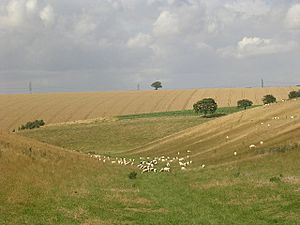The Wolds facts for kids

The Wolds are a special type of low hills found in England. They are mostly open countryside, meaning there aren't many trees. These hills are made up of soft rocks like limestone or chalk underneath the surface.
Contents
What are the Wolds?
The Wolds are a series of gentle hills and steep valleys. Most of these areas have rocks like chalk, limestone, and sandstone beneath them. These rocks were formed a very long time ago, during the Cretaceous and Jurassic periods.
One special area, the North Leicestershire and South Nottinghamshire Wolds, is a bit different. It has a type of soil called 'Oadby Till', which sometimes contains chalk.
How the Valleys Formed
The unique, open valleys of the Wolds were created during the last Ice Age. Huge sheets of ice and melting water carved out these shapes. The chalk rock that forms the Wolds stretches from the Yorkshire Wolds all the way to the south coast of England. You can find it in places like East Sussex and Dorset.
Wolds Across England
The Lincolnshire Wolds are actually a natural continuation of the Yorkshire Wolds. These two hill ranges are connected, and they cross the Humber River at a narrow point called the Humber Gap.
Where Does the Name "Wolds" Come From?
The word Wold comes from an old English word, wald. This word originally meant "forest." It's similar to the German word Wald, which also means forest.
Over many years, the meaning of Wold changed. It went from meaning "forest" to "open high ground." This probably happened because the forests on these high lands were cleared away, but the original name stuck. You can see this in famous areas like the Cotswolds, the Lincolnshire Wolds, and the Yorkshire Wolds.
Wolds in Literature
The Wolds have inspired writers and poets for a long time. Here are a couple of examples:
- The writer Winifred Holtby described the Yorkshire Wolds like this:
Westward before her rose fold upon fold of the encircling hills, piled rich and golden.
- The famous poet Alfred Tennyson mentioned the Wolds in his poem The Lady of Shalott:
On either side the river lie/Long fields of barley and of rye,/That clothe the wold and meet the sky;
See also
 In Spanish: The Wolds para niños
In Spanish: The Wolds para niños

